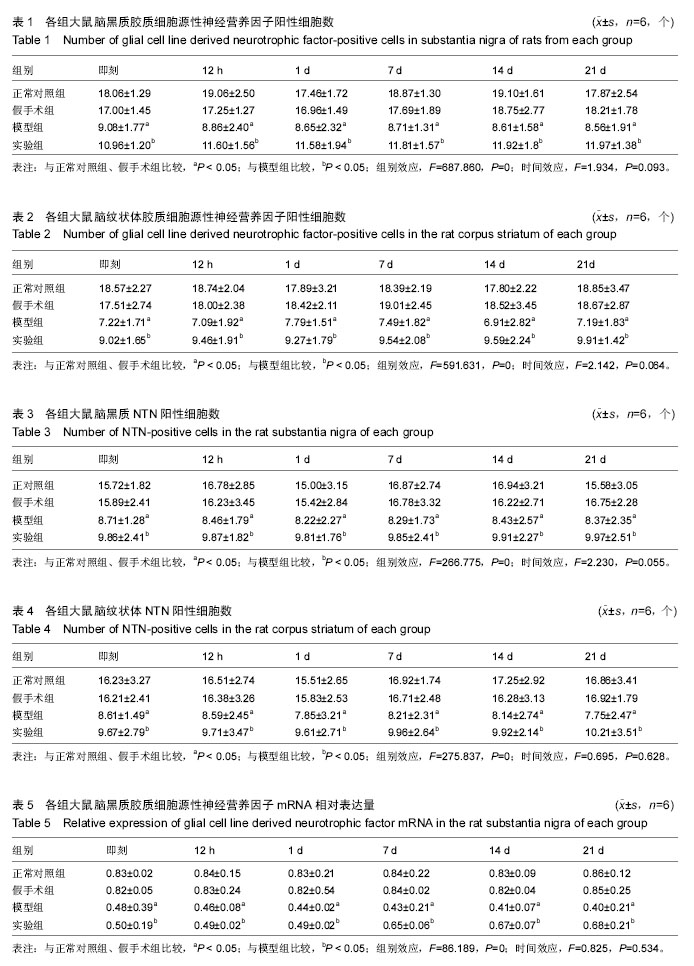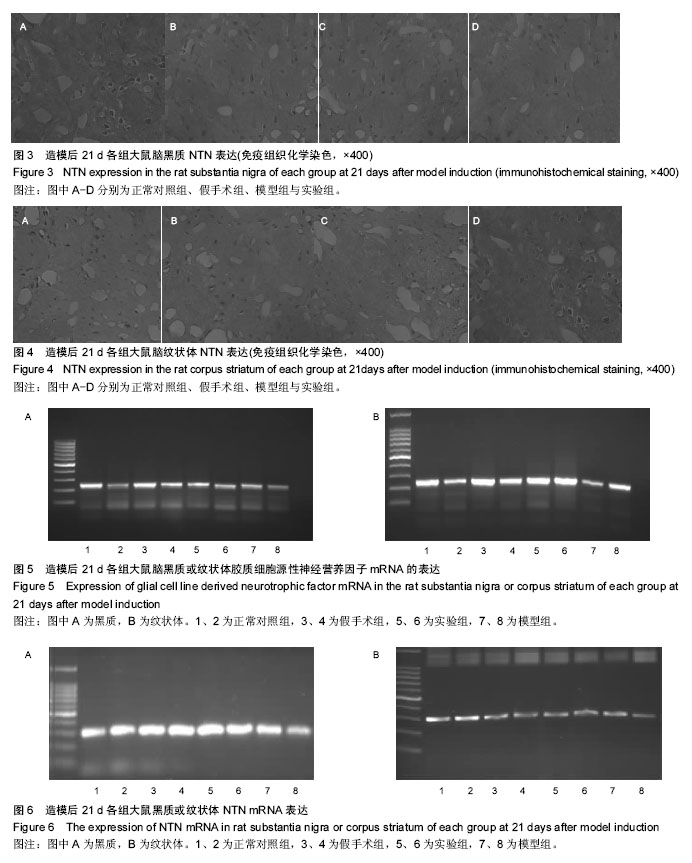中国组织工程研究 ›› 2016, Vol. 20 ›› Issue (27): 4020-4028.doi: 10.3969/j.issn.2095-4344.2016.27.010
• 脑及脊髓损伤动物模型 Animal models of brain and spinal cord injuries • 上一篇 下一篇
米诺环素对帕金森病模型大鼠胶质细胞源性神经营养因子家族的影响
邢红霞1,姜建凯2,秦栎媛3,王玉梅4
- 新乡医学院第一附属医院神经内科,1五病区,4一病区,河南省新乡市 453100;2郑州市第一人民医院神经内科,河南省郑州市 450000;3南阳市中心医院神经内科,河南省南阳市 473003
Minocycline affects the expression of glial cell derived neurotrophic factor family in a rat model of Parkinson’s disease
Xing Hong-xia1, Jiang Jian-kai2, Qin Li-yuan3, Wang Yu-mei4
- 1Fifth Ward, 4First Ward, Department of Neurology, the First Affiliated Hospital of Xinxiang Medical College, Xinxiang 453100, Henan Province, China; 2Department of Neurology, Zhengzhou First People’s Hospital, Zhengzhou 450000, Henan Province, China; 3Department of Neurology, Nanyang Center Hospital, Nanyang 473003, Henan Province, China
摘要:
文章快速阅读:
.jpg)
文题释义: 帕金森病:是一种以黑质-纹状体多巴胺神经元进行性变性、多巴胺递质缺乏为主要病理生化基础的慢性中枢神经系统变性疾病,以静止性震颤、肌强直、姿势异常和运动减少为主要表现,目前对帕金森病的治疗是多巴胺替代治疗,以阻止多巴胺能神经元的变性。 米诺环素:是一种半合成的第2代四环素类抗生素,除具有广谱抗菌作用外,可有效穿透血脑屏障,进入中枢神经系统,发挥对神经细胞的保护作用。米诺环素在神经退行性变疾病如帕金森病、肌萎缩侧索硬化、阿尔茨海默病和亨廷顿病的多种实验模型中发挥神经保护作用。Zhao等研究发现,米诺环素可减少帕金森病模型肿瘤坏死因子α的释放。作为一种免疫调节药,米诺环素目前已进入临床试验阶段,很有可能成为治疗帕金森病的有效药物。
摘要 背景:研究发现,米诺环素通过抑制小胶质细胞增殖和活化,抑制胶质细胞释放细胞因子和趋化因子,进而发挥对神经元的保护作用。 目的:探讨米诺环素对帕金森病模型大鼠黑质与纹状体神经胶质细胞源性神经营养因子、NTN及其基因表达的影响。 方法:将144只SD大鼠随机分为4组,每组36只,正常对照组不干预;模型组、实验组在右侧黑质致密部与中脑腹侧背盖区注射6-羟多巴胺,建立帕金森病模型,假手术组于两点注射维生素C,实验组造模成功后即刻灌胃给予4.5 g/L米诺环素45 mg/kg,以后每12 h追加米诺环素22.5 mg/kg,最后一组为正常对照。造模后即刻、12 h、1 d、7 d、14 d、21 d,采用SP免疫组织化学法检测大鼠脑黑质与纹状体胶质细胞源性神经营养因子、NTN表达,RT-PCR方法检测大鼠脑黑质与纹状体胶质细胞源性神经营养因子、NTN mRNA的表达。 结果与结论:不论是在脑黑质还是纹状体中,模型组不同时间点胶质细胞源性神经营养因子、NTN的阳性细胞数及相对基因表达量均低于正常对照组、假手术组(P < 0.05),实验组不同时间点胶质细胞源性神经营养因子、NTN的阳性细胞数及相对基因表达量高于模型组(P < 0.05)。结果表明,米诺环素可通过促进脑黑质胶质细胞源性神经营养因子家族蛋白及基因的表达,延缓帕金森病发病进程。
中图分类号:



.jpg)
.jpg)